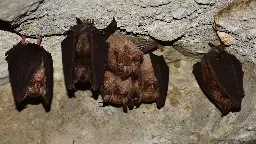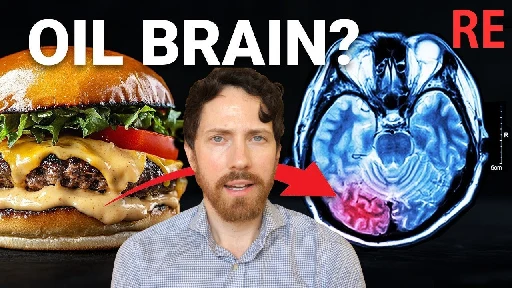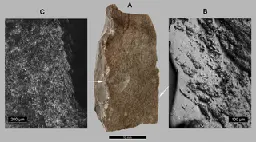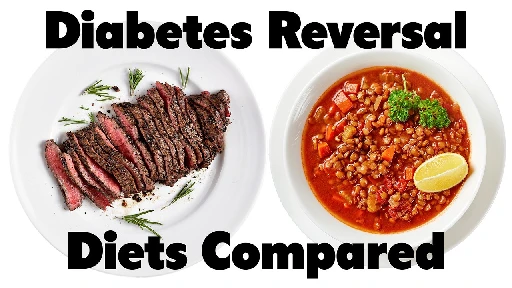
- vegnews.com Breakthrough Research Explains Why Red Meat Raises Cancer Risk
An abundance of research has linked red meat with an increased risk of cancer, but now scientists think they have discovered a key reason why.

> Over-consumption of iron-rich red meat and hereditary or genetic iron overload are associated with an increased risk of colorectal carcinogenesis, yet the mechanistic basis of how metal-mediated signaling leads to oncogenesis remains enigmatic. Using fresh colorectal cancer samples we identify Pirin, an iron sensor, that overcomes a rate-limiting step in oncogenesis, by reactivating the dormant human telomerase reverse transcriptase (hTERT) subunit of the telomerase holoenzyme in an iron-(Fe3+)-dependent manner and thereby drives colorectal cancers. Chemical genetic screens combined with isothermal dose-response fingerprinting and mass spectrometry identified a small molecule SP2509 that specifically inhibits Pirin-mediated hTERT reactivation in colorectal cancers by competing with iron-(Fe3+) binding. Our findings, first to document how metal ions reactivate telomerase, provide a molecular mechanism for the well-known association between red meat and increased incidence of colorectal cancers. Small molecules like SP2509 represent a novel modality to target telomerase that acts as a driver of 90% of human cancers and is yet to be targeted in clinic. > > Significance: We show how iron-(Fe3+) in collusion with genetic factors reactivates telomerase, providing a molecular mechanism for the association between iron overload and increased incidence of colorectal cancers. Although no enzymatic inhibitors of telomerase have entered the clinic, we identify SP2509, a small molecule that targets telomerase reactivation and function in colorectal cancers.
- bigthink.com No, gain of function research did not cause COVID-19
SARS-CoV-2 first emerged in humans in 2019. Despite much noise generated by lab leak proponents, the evidence indicates a natural origin.

CW: images from fur farms
>Put simply, if SARS-CoV-2 came about by frequent recombination through contact with common virus-carrying animals in the wild, we would expect it to display a mix of genome segments shared between it and several of their close cousins. However, if SARS-CoV-2 came about through manipulation in a lab, such as through gain-of-function research, we would expect a close match to one and only one “initial” strain, with the remainder of the genome failing to match any other wild strains. The discovery that SARS-CoV-2 does indeed have what biologists call a mosaic genome makes it abundantly clear that it could not have arisen through laboratory manipulation of an initial, single strain, through gain-of-function research or otherwise.
-
>People who are prejudiced against one social group also tend to be prejudiced against other social groups, that is, they show generalized prejudice. Many scholars have noted parallels between the devaluation and exploitation of certain human groups (e.g., racism, sexism, and other forms of prejudice) and the treatment of non-human animals (often referred to as speciesism), suggesting that generalized prejudice may even extend across species lines. I tested this hypothesis using panel data with large and demographically diverse participant samples and different operationalizations of the devaluation of humans and animals. Study 1 (56,759 participants from 46 European countries) revealed a positive association between human-directed prejudice and human supremacy beliefs and this association was still observed when controlling for various socio-demographic factors (e.g., gender, educational attainment, religiosity, political orientation). Study 2 (1,566 Dutch participants) revealed positive associations between human-directed prejudice and a host of attitudes, beliefs, emotional responses, and behaviors related to meat consumption. For the majority of tests, this positive association was still observed when controlling for socio-demographic factors. Thus, both studies suggest that people who devalue human groups also tend to devalue the welfare and interests of animals. The current findings support recent theorizing on the common psychological roots of human-directed and animal-directed prejudice and attest to the generality of generalized prejudice.
Article about this paper: https://faunalytics.org/devaluation-of-animals-is-linked-to-devaluation-of-humans/
-
The $212 Billion Dollar Food ingredient poisoning your Brain? RE: What I've Learned

YouTube Video
Click to view this content.
>Seed oils like canola give you "Oil Brain" and we would be dumb without fish according to What I've Learned. Let's see if the claims add up.
The "how I failed to learn" YouTube channel is at it again.
-
Characterizing the Areal Extent of PFAS Contamination in Fish Species Downgradient of AFFF Source Zones
>Most monitoring programs next to large per- and polyfluoroalkyl substances (PFAS) sources focus on drinking water contamination near source zones. However, less is understood about how these sources affect downgradient hydrological systems and food webs. Here, we report paired PFAS measurements in water, sediment, and aquatic biota along a hydrological gradient away from source zones contaminated by the use of legacy aqueous film-forming foam (AFFF) manufactured using electrochemical fluorination. Clustering analysis indicates that the PFAS composition characteristic of AFFF is detectable in water and fishes >8 km from the source. Concentrations of 38 targeted PFAS and extractable organofluorine (EOF) decreased in fishes downgradient of the AFFF-contaminated source zones. However, PFAS concentrations remained above consumption limits at all locations within the affected watershed. Perfluoroalkyl sulfonamide precursors accounted for approximately half of targeted PFAS in fish tissues, which explain >90% of EOF across all sampling locations. Suspect screening analyses revealed the presence of a polyfluoroketone pharmaceutical in fish species, and a fluorinated agrochemical in water that likely does not accumulate in biological tissues, suggesting the presence of diffuse sources such as septic system and agrochemical inputs throughout the watershed in addition to AFFF contamination. Based on these results, monitoring programs that consider all hydrologically connected regions within watersheds affected by large PFAS sources would help ensure public health protection.
- journals.plos.org The Origin of Cultivation and Proto-Weeds, Long Before Neolithic Farming
Weeds are currently present in a wide range of ecosystems worldwide. Although the beginning of their evolution is largely unknown, researchers assumed that they developed in tandem with cultivation since the appearance of agricultural habitats some 12,000 years ago. These rapidly-evolving plants inv...

>Weeds are currently present in a wide range of ecosystems worldwide. Although the beginning of their evolution is largely unknown, researchers assumed that they developed in tandem with cultivation since the appearance of agricultural habitats some 12,000 years ago. These rapidly-evolving plants invaded the human disturbed areas and thrived in the new habitat. Here we present unprecedented new findings of the presence of “proto-weeds” and small-scale trial cultivation in Ohalo II, a 23,000-year-old hunter-gatherers' sedentary camp on the shore of the Sea of Galilee, Israel. We examined the plant remains retrieved from the site (ca. 150,000 specimens), placing particular emphasis on the search for evidence of plant cultivation by Ohalo II people and the presence of weed species. The archaeobotanically-rich plant assemblage demonstrates extensive human gathering of over 140 plant species and food preparation by grinding wild wheat and barley. Among these, we identified 13 well-known current weeds mixed with numerous seeds of wild emmer, barley, and oat. This collection provides the earliest evidence of a human-disturbed environment—at least 11 millennia before the onset of agriculture—that provided the conditions for the development of "proto-weeds", a prerequisite for weed evolution. Finally, we suggest that their presence indicates the earliest, small-scale attempt to cultivate wild cereals seen in the archaeological record.
-
Animal-welfare-labelled meat is not a stepping stone to animal-free diets: empirical evidence from a survey
>A survey is used to test a stepping stone model for meat reduction and farm animal suffering elimination. People’s preferences to eat conventional meat, animal-welfare-certified meat and plant-based meat substitutes are measured in hypothetical situations where everyone else eats certified meat or plant-based meat substitutes. These preferences reflect social norms about food. When everyone else follows a harmful social norm, such as eating conventional meat, violating this norm by following a different diet becomes costly due to social sanctions. Either the survey method has a low sensitivity to detect real stepping stones, or the survey evidence suggests that animal-welfare-labelled meat is not a stepping stone towards the reduction and elimination of animal-based meat. If people transition to eating welfare-labelled meat, they may become less likely to eliminate meat from their diet. Everyone eating welfare-labelled meat is an absorbing state, which prevents a further transition to animal-free meat substitutes. The survey shows very weak and mixed evidence that the introduction of an animal welfare label could be counterproductive for animal welfare. In the long run it could result in a locked-in equilibrium with a less harmful social norm, i.e. a suboptimal state of animal farming that still contains animal suffering.
-
2 Diabetes Reversal Programs: 1 Winner.

YouTube Video
Click to view this content.
- 0:00 The Virta Health approach
- 1:30 The Salud en tu Plato approach
- 3:58 Patient results
- 8:11 Salud's medical director
- 9:16 Salud's diet
- 12:17 A truck driver story
- 15:35 The Hispanic diabetes epidemic
- 18:12 The practical side
- 21:03 Funding the program
- 23:14 Virta Health & ketosis don't work
There's a list of references in the video description. I'm not going to paste them because they're YouTube redirection links which are personalized with tracking.
-
The highly pathogenic H5N1 virus found in U.S. dairy cattle has some characteristics that could enhance infection and transmission among mammals
www.nature.com The highly pathogenic H5N1 virus found in U.S. dairy cattle has some characteristics that could enhance infection and transmission among mammals - Lab AnimalA highly pathogenic H5N1 influenza virus is spreading in U.S. dairy cattle and has been transmitted to other species, including humans, probably through contaminated milk. Understanding how the virus spreads among cattle and its potential for mammalian adaptation and airborne transmission is crucial...
This is a letter/comment on its own. Read it.
-
Reducing climate change impacts from the global food system through diet shifts
www.nature.com Reducing climate change impacts from the global food system through diet shifts | Nature Climate ChangeHow much and what we eat and where it is produced can create huge differences in GHG emissions. On the basis of detailed household-expenditure data, we evaluate the unequal distribution of dietary emissions from 140 food products in 139 countries or areas and further model changes in emissions of gl...

>How much and what we eat and where it is produced can create huge differences in GHG emissions. On the basis of detailed household-expenditure data, we evaluate the unequal distribution of dietary emissions from 140 food products in 139 countries or areas and further model changes in emissions of global diet shifts. Within countries, consumer groups with higher expenditures generally cause more dietary emissions due to higher red meat and dairy intake. Such inequality is more pronounced in low-income countries. The present global annual dietary emissions would fall by 17% with the worldwide adoption of the EAT-Lancet planetary health diet, primarily attributed to shifts from red meat to legumes and nuts as principal protein sources. More than half (56.9%) of the global population, which is presently overconsuming, would save 32.4% of global emissions through diet shifts, offsetting the 15.4% increase in global emissions from presently underconsuming populations moving towards healthier diets.
News explainer: Changing food consumers' choices may help cut greenhouse gases | ScienceDaily